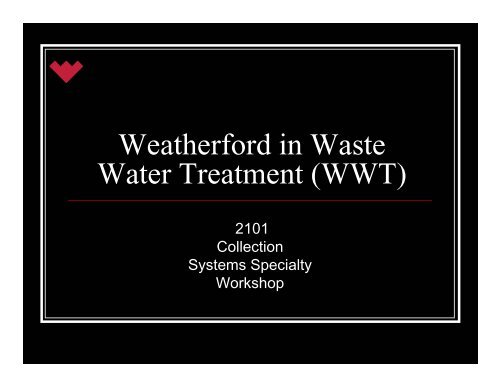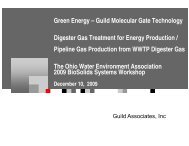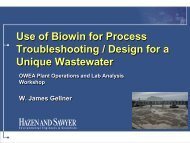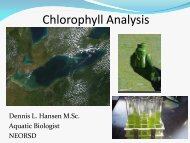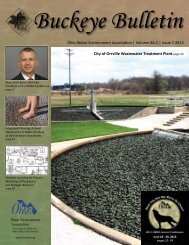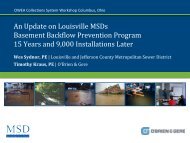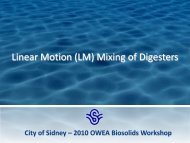Weatherford in Waste Water Treatment (WWT)
Weatherford in Waste Water Treatment (WWT)
Weatherford in Waste Water Treatment (WWT)
You also want an ePaper? Increase the reach of your titles
YUMPU automatically turns print PDFs into web optimized ePapers that Google loves.
<strong>Weatherford</strong> <strong>in</strong> <strong>Waste</strong><br />
<strong>Water</strong> <strong>Treatment</strong> (<strong>WWT</strong>)<br />
2101<br />
Collection<br />
Systems Specialty<br />
Workshop
Who is <strong>Weatherford</strong> Eng<strong>in</strong>eered Chemistry ?<br />
• A division of <strong>Weatherford</strong> International<br />
• Primarily servic<strong>in</strong>g the <strong>in</strong>dustrial<br />
market, oil and gas bus<strong>in</strong>ess, and<br />
waste water treatment <strong>in</strong>dustries<br />
• Three ISO 9001 registered plants and<br />
one ISO 14001 registered plant
Core Bus<strong>in</strong>ess<br />
• Eng<strong>in</strong>eered Chemistry<br />
• Hydrogen Sulfide Gas Removal<br />
• Oil and Gas Services<br />
• Plant Air Moisture Reduction
Locations<br />
• Manufactur<strong>in</strong>g facilities located <strong>in</strong><br />
Pittsburgh, PA, San Antonio, TX, Odessa,<br />
TX, Newburgh, IN, and Red Deer, Alberta<br />
• Support offices <strong>in</strong> Pittsburgh, Orlando,<br />
Houston, Calgary, Moscow, Dubai, and Rio<br />
de Janeiro, Beij<strong>in</strong>g, and Argent<strong>in</strong>a
<strong>Weatherford</strong>, Pittsburgh
<strong>Weatherford</strong>, San Antonio
<strong>Weatherford</strong>, Newburgh, IN
<strong>Weatherford</strong>, Canada
What is H 2 S?<br />
• Hydrogen sulfide is a corrosive,<br />
poisonous gas<br />
• Heavier than air<br />
• Rotten egg odor at low concentrations -<br />
H 2 S Sources<br />
• Natural occurr<strong>in</strong>g <strong>in</strong> oil & gas reservoirs – ppm<br />
levels to high % range<br />
• H 2 S forms from the activity of sulfate reduc<strong>in</strong>g<br />
bacteria.<br />
• Under anaerobic conditions, the sulfate ion is<br />
used as a source of oxygen for respiration by<br />
some bacteria<br />
• <strong>Water</strong> phase, <strong>in</strong>clud<strong>in</strong>g waste water<br />
process<strong>in</strong>g, water disposal wells, etc.
Where is H 2 S<br />
• Generated <strong>in</strong> Subterranean Foundations<br />
• Potable Dr<strong>in</strong>k<strong>in</strong>g <strong>Water</strong><br />
• Natural Gas<br />
• Crude Oil<br />
• Sewage Plants<br />
• Liquid<br />
• Vapor<br />
• Landfills
H 2 S Toxicity<br />
0.13 ppm m<strong>in</strong>imal odor<br />
4.60 ppm moderate identifiable odor<br />
10 ppm <strong>in</strong>itial eye irritation<br />
27 ppm strong odor<br />
100 ppm cough<strong>in</strong>g, loss of sense of<br />
smell after 2-5 m<strong>in</strong>utes<br />
200-300 ppm eye <strong>in</strong>flammation<br />
respiratory tract irritation<br />
500-700 ppm loss of consciousness and<br />
possible death <strong>in</strong> 30 m<strong>in</strong>. to 1 hr<br />
700-1000 ppm rapid unconsciousness, death
• Liquid scavenger<br />
• Sulfa-Clear<br />
• Iron Salts<br />
• pH Control<br />
• Oxidation<br />
<strong>Treatment</strong><br />
• Alternative food sources for the SRB<br />
bacteria
What is Sulfa-Clear<br />
• Patented technology that safely and effectively removes<br />
H 2 S<br />
• Twenty year old technology used <strong>in</strong> the oil & gas<br />
<strong>in</strong>dustry<br />
• Polymeric Am<strong>in</strong>e Condensate that converts sulfide to a<br />
Polyam<strong>in</strong>e Sulfide<br />
• Used <strong>in</strong> Scrubber Towers, Bubble Towers, Static<br />
Mixers, Absorption Towers, and Collection Systems<br />
• Introduced by s<strong>in</strong>gle or multiple <strong>in</strong>jection po<strong>in</strong>ts by<br />
atomization and drip feed<strong>in</strong>g
Sulfa-Clear<br />
• Non-Hazardous<br />
• Non-Flammable<br />
• Freeze po<strong>in</strong>t <strong>in</strong> excess of -20F<br />
• No special storage considerations
Why Use Sulfa-Clear<br />
• Efficient and cost effective way to remove H 2 S<br />
• Reacts to form a corrosion <strong>in</strong>hibitor<br />
• Reduces ma<strong>in</strong>tenance costs<br />
• Reduces solids build up<br />
• Environmentally friendly<br />
• Ease of handl<strong>in</strong>g<br />
• Mercaptant removal
WSC Sulfa Clear 8640 HF<br />
<strong>in</strong><br />
Liquid Phase<br />
• Is a true scavenger<br />
• H2S will not reoccur<br />
• Reacts <strong>in</strong>to a polymer<br />
• Sulfa Clear can withstand temperatures as low as -20 F without<br />
viscosity and freez<strong>in</strong>g problems<br />
• Is selective only to H2S methyl, ethyl & diethyl mercaptan<br />
• Needs turbulence to be effective<br />
• Works best <strong>in</strong> forced ma<strong>in</strong>s or prior to the suction side of the pump<br />
go<strong>in</strong>g to a sludge hold<strong>in</strong>g tank<br />
• Will remove odors <strong>in</strong> collections, wet scrubbers, and belt press<br />
rooms<br />
• Will not work well <strong>in</strong> a gravity ma<strong>in</strong><br />
• Test<strong>in</strong>g is <strong>in</strong> progress to make the molecule proactive
WSC Sulfa Clear 8811-C<br />
• Both <strong>Water</strong> and Oil Soluble<br />
• All the same characteristics as 8640-HF<br />
• Oil Phase attacks H2S <strong>in</strong> the Slime Layer<br />
• <strong>Water</strong> Soluble is 8640 HF<br />
• Twice the cost<br />
• Above 30 GPD <strong>in</strong> a Collection System<br />
• One Test Location went from 19 GPD to 2 GPD
Spent Solution<br />
example hazards analysis<br />
Results<br />
Limit<br />
Flammability:<br />
Flash pt 0 F >212 >140<br />
Corrosivity:<br />
pH 7.0 12.5<br />
Reactivity:<br />
Sulfide nonreactive 500ppm<br />
Cyanide nonreactive 250ppm<br />
Metals<br />
no heavy metals or halogens
<strong>Weatherford</strong> Eng<strong>in</strong>eered<br />
Chemistry<br />
In<br />
<strong>Waste</strong> <strong>Water</strong> <strong>Treatment</strong><br />
Collection Systems
Collection Systems<br />
• H2S Reduction<br />
• Mercaptan removal<br />
• Corrosion Inhibitor<br />
• Odor Control
<strong>Treatment</strong> Procedure<br />
• Determ<strong>in</strong>e H2S Levels<br />
• Gastec Sulfide Detection Tubes <strong>in</strong> Liquid<br />
• Odalog Gas Detector <strong>in</strong> Vapor<br />
• Beg<strong>in</strong> Drip Feed<strong>in</strong>g Sulfa-Clear<br />
• GPD x ppm H2S /1,000,000 x 4 = GPD<br />
• 500,000 x 8 = 4,000,000 x 4 = 16 / 24 = .67<br />
GPH
Results<br />
• Reduction <strong>in</strong> H2S Levels<br />
• Reduction <strong>in</strong> Odor Compla<strong>in</strong>ts<br />
• Reduction <strong>in</strong> Solids Build-up<br />
• Reduced Corrosion
Trial with City of Hermitage, PA<br />
• This trial was conducted under the supervision of<br />
Hickory Eng<strong>in</strong>eer<strong>in</strong>g to test the performance of<br />
Sulfa-Clear for removal of H2S <strong>in</strong> collection systems.<br />
• One resident was compla<strong>in</strong><strong>in</strong>g of H2S <strong>in</strong> his<br />
residence caus<strong>in</strong>g a health hazard<br />
• Flow rates and H2S levels were determ<strong>in</strong>ed<br />
• Started dos<strong>in</strong>g at the rate of 5 GPD<br />
• Levels were reduced from 100 ppm to less than 4<br />
ppm H2S <strong>in</strong> vapor
Before treatment<br />
Hermitage<br />
120<br />
100<br />
80<br />
ppm H2S<br />
H2S<br />
60<br />
40<br />
20<br />
0<br />
3:30<br />
PM<br />
8:00<br />
PM<br />
12:00<br />
AM<br />
5:00<br />
AM<br />
10:00<br />
AM<br />
3:00<br />
PM<br />
8:00<br />
PM<br />
12:00<br />
AM<br />
5:00<br />
AM<br />
10:00<br />
AM<br />
3:50<br />
PM<br />
8/9/2005 8/10/2005 8/11/2005<br />
Time & Date
After treatment<br />
Hermitage<br />
ppm H2S<br />
7<br />
6<br />
5<br />
ppm<br />
4<br />
3<br />
2<br />
1<br />
0<br />
2:00<br />
PM<br />
8:00<br />
PM<br />
12:00<br />
AM<br />
5:00<br />
AM<br />
10:00<br />
AM<br />
3:00<br />
PM<br />
8:00<br />
PM<br />
12:00<br />
AM<br />
5:00<br />
AM<br />
9:00<br />
AM<br />
9/5/2005 9/6/2005 9/7/2005<br />
Time and Date
•<br />
Sample Rd. Heritage, Pa.
Corrosion Rates<br />
• Two similar l<strong>in</strong>es 350,000 GPD Flow Rate<br />
• 4-6 ppm Dissolved Sulfides<br />
• No treatment 9 mills plus annual metal loss<br />
• Treated l<strong>in</strong>e less than 1 mill annual metal<br />
loss
Summit County<br />
• Trial at LS-107 & LS-86<br />
• Recurrence of H2S downstream of LS-89 to LS-86<br />
• Sampl<strong>in</strong>g was taken daily dur<strong>in</strong>g trial period<br />
• Both liquid and vapor samples were taken<br />
• Sampl<strong>in</strong>g was also conducted by Ben Duke, Summit<br />
County<br />
• Summit County has converted this location to<br />
Sulfa-Clear
Lift Station 107<br />
Dur<strong>in</strong>g <strong>Treatment</strong><br />
LS-107<br />
80<br />
70<br />
60<br />
50<br />
40<br />
PPM H2S Liquid<br />
PPM H2S Vapor<br />
30<br />
20<br />
10<br />
0<br />
LS-107 LS-107 LS-107 LS-107 LS-107 LS-107 LS-107 LS-107 LS-107 LS-107 LS-107 LS-107 LS-107<br />
7-Aug 8-Aug 9-Aug 10-Aug 12-Aug 15-Aug 17-Aug 22-Aug 23-Aug 24-Aug 30-Aug 4-Sep 5-Sep
Manhole on Arl<strong>in</strong>gton<br />
MH-107<br />
120<br />
100<br />
80<br />
60<br />
PPM H2S Liquid<br />
PPM H2S Vapor<br />
40<br />
20<br />
0<br />
MH-107 MH-107 MH-107 MH-107 MH-107 MH-107 MH-107 MH-107 MH-107 MH-107 MH-107 MH-107 MH-107<br />
7-Aug 8-Aug 9-Aug 10-Aug 12-Aug 15-Aug 17-Aug 22-Aug 23-Aug 24-Aug 30-Aug 4-Sep 5-Sep
Lift Station 86<br />
LS-86<br />
30<br />
25<br />
20<br />
15<br />
PPM H2S Liquid<br />
PPM H2S Vapor<br />
10<br />
5<br />
0<br />
LS-86 LS-86 LS-86 LS-86 LS-86 LS-86 LS-86 LS-86 LS-86 LS-86 LS-86 LS-86 LS-86<br />
7-Aug 8-Aug 9-Aug 10-Aug 12-Aug 15-Aug 17-Aug 22-Aug 23-Aug 24-Aug 30-Aug 4-Sep 5-Sep
Manhole for LS-86<br />
MH-86<br />
16<br />
14<br />
12<br />
10<br />
8<br />
PPM H2S Liquid<br />
PPM H2S Vapor<br />
6<br />
4<br />
2<br />
0<br />
MH-86 MH-86 MH-86 MH-86 MH-86 MH-86 MH-86 MH-86 MH-86 MH-86 MH-86 MH-86 MH-86<br />
7-Aug 8-Aug 9-Aug 10-Aug 12-Aug 15-Aug 17-Aug 22-Aug 23-Aug 24-Aug 30-Aug 4-Sep 5-Sep
Lift Station 108
Lift Station 108
Stark County<br />
• H2S levels as high as 500 ppm <strong>in</strong> vapor<br />
• Flows <strong>in</strong>to Summit County<br />
• Uneconomical with Thiogaurd<br />
• 75 GPD of Thiogaurd to reduce H2S to 40 ppm<br />
• <strong>Treatment</strong> with Sulfa-Clear 7 GPD<br />
• H2S levels below 40 ppm<br />
• Sampl<strong>in</strong>g data is from Rod Dray, Stark County
180<br />
160<br />
140<br />
120<br />
100<br />
80<br />
60<br />
40<br />
20<br />
0<br />
Stark County, OH<br />
Stark County<br />
11/9/2007<br />
11/16/2007<br />
11/23/2007<br />
11/30/2007<br />
12/7/2007<br />
12/14/2007<br />
12/21/2007<br />
12/28/2007<br />
1/4/2008<br />
1/11/2008<br />
1/18/2008<br />
1/25/2008<br />
2/1/2008<br />
2/8/2008<br />
2/15/2008<br />
2/22/2008<br />
2/29/2008<br />
3/7/2008<br />
3/14/2008<br />
3/21/2008<br />
3/28/2008<br />
4/4/2008<br />
4/11/2008<br />
4/18/2008<br />
4/25/2008<br />
Date<br />
Conc of H2S<br />
H2S (ppm)
City of Canton<br />
• The Quarry Golf Course<br />
• Current treatment magnesium hydroxide<br />
• Spikes of H2S highas 160 ppm<br />
• Reduction to Zero ppm as of last week
City of Canton
City of Canton
City of Canton
Summary<br />
• Effective H 2 S control<br />
• Reduced<br />
ma<strong>in</strong>tenance cost<br />
• Reduced solids<br />
• Better odor control<br />
• Safe<br />
• Economical<br />
• Increased equipment<br />
life<br />
• Improved public<br />
relations
WSC ORM Dry Filter<br />
•<br />
• Removes H2S<br />
• Removes<br />
Mercaptan<br />
• Cartridge Design<br />
• Long Last<strong>in</strong>g Media<br />
• Low Ma<strong>in</strong>tenance<br />
• Ease of Disposal
WSC Dry Filter ORM<br />
• Read<strong>in</strong>gs taken by Odalog & Jerome H2S<br />
logg<strong>in</strong>g sensors units<br />
• One placed <strong>in</strong> the MH or LS<br />
• One <strong>in</strong> the exhaust of the filter<br />
• Both units are changed weekly<br />
• Media will not solidify
WSC ORM Dry Filter<br />
Initial Data
Stark County<br />
Latest Data
Stark County<br />
Latest Data
Tw<strong>in</strong> Creek, Fla.
Tw<strong>in</strong> Creek, Fla.
ORM Media<br />
• Silica Media Saturated with Sulfa Clear<br />
8640-HF<br />
• Direct Replacement for Activated Carbon<br />
• Direct Replacement for Sulfa Treat Media<br />
• Longer Last<strong>in</strong>g<br />
• Used <strong>in</strong> Carbon Canisters<br />
• Used as a Polish<strong>in</strong>g Filter on Bio-Filters
Columbia Analytical Labs<br />
• Measur<strong>in</strong>g results <strong>in</strong> ppb<br />
• Us<strong>in</strong>g Radeillo Samplers<br />
• Less than .05 ppb after five months<br />
• Verify<strong>in</strong>g results us<strong>in</strong>g Odalog unit<br />
beg<strong>in</strong>n<strong>in</strong>g week of 5/17/10
adiello® Sampler<br />
• Passive/diffusive sampl<strong>in</strong>g<br />
• Z<strong>in</strong>c acetate treated<br />
• No hold<strong>in</strong>g time issues<br />
• Polyethylene Report<strong>in</strong>g limit decreases<br />
<strong>in</strong>creased duration<br />
exposure<br />
• Potential pptV level sensitivity<br />
• Methylene blue: visible spectrometry<br />
Picture courtesy of<br />
Sigma Aldrich
Columbia Results
Alternatives to Sulfa Clear Products<br />
• Thiogaurd (mag hydroxide)<br />
• Bioxide (calcium nitrate)<br />
• Nitronox (sodium nitrate)<br />
• Potassium Permanganate<br />
• Caustic<br />
• Bleach<br />
• Biological <strong>Treatment</strong><br />
• Peroxide (any oxidation)<br />
• Ferrous & Ferric Chloride
Thiogaurd<br />
• Magnesium Hydroxide<br />
• Raises pH keeps pH above 7 and keeps<br />
H2S <strong>in</strong> a liquid state liquid<br />
• When reaction is spent H2S will release <strong>in</strong><br />
vapor down stream<br />
• Very viscous demands constant agitation<br />
• Needs heat<strong>in</strong>g <strong>in</strong> cold weather<br />
• Known to clog pumps and valves
Bioxide<br />
• Basically calcium nitrate an alternative food source to the<br />
SRB bacteria<br />
• When the Bioxide is consumed the SRB consume sulfates<br />
• Normally the SRB colony has grown need<strong>in</strong>g multiple<br />
<strong>in</strong>jection po<strong>in</strong>ts from the <strong>in</strong>itial start up over a period of time<br />
• Nitronox or sodium nitrate causes the same problems<br />
• However is half the cost of Bioxide but normally needs twice<br />
the consumption rate to achieve the same results<br />
• Bioxide also forms <strong>in</strong>to what is called a bio-matt that needs to<br />
be physically vacuumed from each lift station depend<strong>in</strong>g on<br />
flow rate. It actually looks like a FOG matt
Potassium Permanganate<br />
• It is a true scavenger<br />
• Highly Corrosive<br />
• Precipitates out solids<br />
• Offensive odor
• Simply pH control<br />
Caustic & Bleach<br />
• Raises the pH above 7 forc<strong>in</strong>g H2S <strong>in</strong>to<br />
liquid<br />
• When reaction is spent turbulence will<br />
cause H2S to liberate <strong>in</strong>to vapor<br />
• Very corrosive and hazardous<br />
• Requires special handl<strong>in</strong>g
Biological <strong>Treatment</strong><br />
• Biofilters and bio-trickl<strong>in</strong>g filters work<br />
• To an extent work very well and is the wave of the future<br />
• Normally H2S returns<br />
• Requires a very large foot pr<strong>in</strong>t above 80 ppm H2S<br />
• Normally need a carbon filter to handle break troughs<br />
• Or hopefully our new ORM media to handle breakthroughs<br />
better than carbon
Oxidation<br />
• Peroxide or direct air <strong>in</strong>jection<br />
• Adds a third O2 molecule<br />
• Extra O2 forces sulfide back to a sulfate stage<br />
• When O2 is spent SRB bacteria reconsume<br />
sulfate and excrete sulfide<br />
• Once aga<strong>in</strong> moves does not remove
Iron Salts<br />
• Ferrous & Ferric Chloride<br />
• True scavengers<br />
• Precipitate out iron sulfides<br />
• Case studies have shown the precipitants<br />
to break pipel<strong>in</strong>es<br />
• Needs agitation<br />
• Not friendly to cold weather


